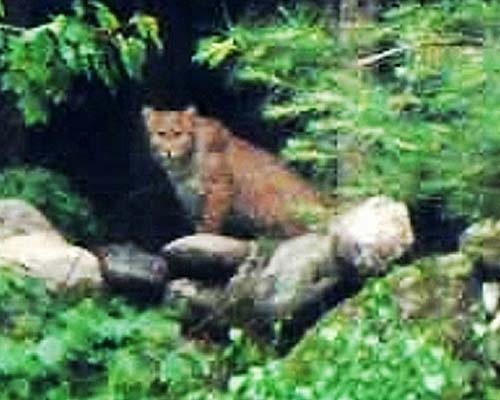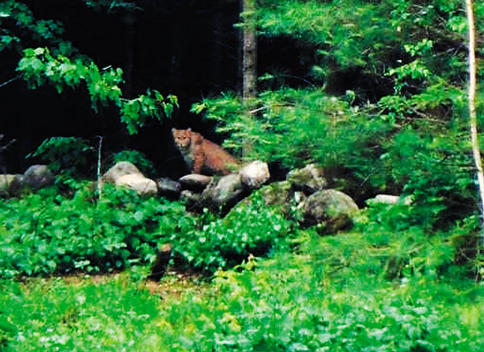
June 29, 2007
Click on image for full size version
Maine officials taking big cat photo seriously
By Kathryn Skelton , Staff Writer
Friday, June 29, 2007
A photo making e-mail rounds Thursday [June 28, 2007] that shows what looks like a big, rare cat in a Sidney backyard is real, according to the Department of Inland Fisheries & Wildlife spokesman.
Whether that’s actually a mountain lion leaning on a rock wall is up in the air. The cat’s tail, the easiest way to tell a bobcat from a mountain lion, is hidden by a tree.
“That’s why we’re sending someone out there,” said Mark Latti. “Maine doesn’t have a wild population of mountain lions.”
The picture came in to IFW on Thursday. He said the homeowner wants to be anonymous. A biologist will go out soon to look for other evidence, like tracks, and measure the size of the rocks where the cat stood to get a sense of scale.
Maine hasn’t had wild mountain lions since the late 1800s, Latti said. Vermont and New Hampshire don’t have them either.
“We do receive a handful of sightings a year,” he added. The last significant one was about six years ago in Monmouth. Plaster casts were made of what turned out to be mountain lion tracks, “but we never saw it again.”
In the mid-1990s, mountain lion hair was found in Cape Elizabeth.
The animals live mostly out West and sometimes make headlines with vicious attacks. According to SanDiegoZoo.org, the male mountain lion can get up to six feet long and 227 pounds.
Central Maine Medical Center spokesman Randy Dustin had a friend send him the photo with a note that read, “This thing ran in front of me the other night in Sidney.” It was on the Turnpike and the friend thought he’d been seeing things.
“I think it could be real,” he said. “It’s exciting.” Lewiston Sun Journal, Lewiston, Maine, June 29, 2007

Curious photo prompts investigation
Could this be a mountain lion? A Sidney resident thinks it could and a biologist is investigating.
By Joel Elliott/Blethen Maine News Service
Sidney — A state biologist is investigating a claim that someone here sighted a mountain lion.
An anonymous resident sent a photo of the animal to the state Inland Fisheries and Wildlife Department, and experts there have yet to determine its validity, according to department spokesman Mark Latti.
“The photo is inconclusive, just because of the perspective, and it only shows part of the cat,” he said.
Latti said it would be easier to determine the type of cat if the back end were visible in the photo, because long tails are a distinctive feature of mountain lions.
The department receives similar calls sporadically from residents across the state, but biologists have not found evidence that they consider to be conclusive proof of the cats’ presence, Latti said.
“There is not a wild population of mountain lions or cougars in the state,” he said. “However, there’s a very real possibility that someone could have brought it in from another state and released it. Or it could be an escaped domestic one.”
If wild mountain lions were in the state, Latti said, there would be more sightings or hard evidence, like road kill.
“While it is a possibility, we just don’t have enough evidence to substantiate it,” he said. [Contributed photo] Portland Press Herald, Portland, Maine, June 29, 2007.

About Loren Coleman
Loren Coleman is one of the world’s leading cryptozoologists, some say “the” leading living cryptozoologist. Certainly, he is acknowledged as the current living American researcher and writer who has most popularized cryptozoology in the late 20th and early 21st centuries.
Starting his fieldwork and investigations in 1960, after traveling and trekking extensively in pursuit of cryptozoological mysteries, Coleman began writing to share his experiences in 1969. An honorary member of Ivan T. Sanderson’s Society for the Investigation of the Unexplained in the 1970s, Coleman has been bestowed with similar honorary memberships of the North Idaho College Cryptozoology Club in 1983, and in subsequent years, that of the British Columbia Scientific Cryptozoology Club, CryptoSafari International, and other international organizations. He was also a Life Member and Benefactor of the International Society of Cryptozoology (now-defunct).
Loren Coleman’s daily blog, as a member of the Cryptomundo Team, served as an ongoing avenue of communication for the ever-growing body of cryptozoo news from 2005 through 2013. He returned as an infrequent contributor beginning Halloween week of 2015.
Coleman is the founder in 2003, and current director of the International Cryptozoology Museum in Portland, Maine.
Filed under Alien Big Cats, Breaking News, CryptoZoo News, Cryptozoologists, Cryptozoology, Mystery Cats, Photos